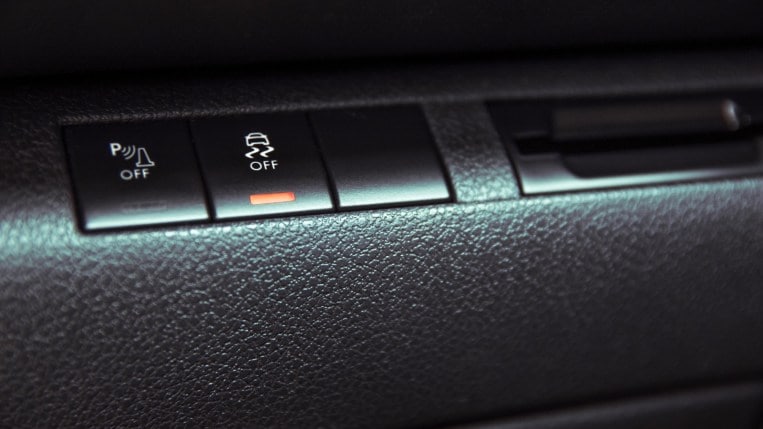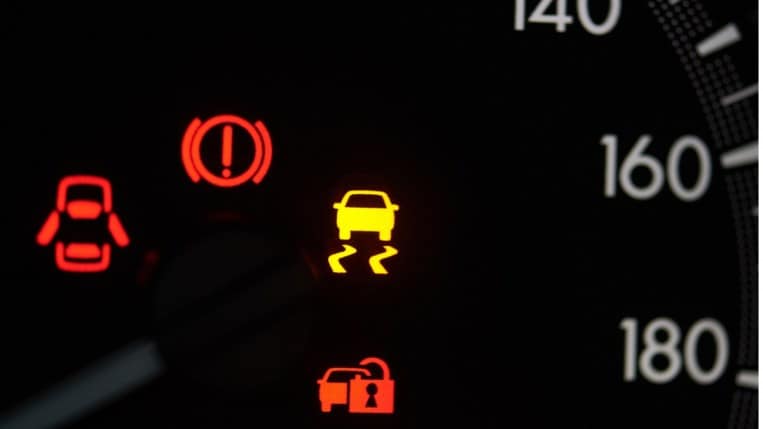Traction Control System: How It Works and When To Use It
By Austin Morris 06/06/2023 8:00am

Traction Control System Quick Facts
- The traction control system (TCS) is a safety system that detects when a car’s wheel slips and loses grip on the road. The system then automatically slows the slipping wheel’s speed.
- Traction control became standard on every car starting in 2012.
- TCS automatically engages unless turned off.
- The only time to turn off traction control is when stuck in mud, sand, snow, or ice.
Driving at night during a rain or snowstorm can be a scary experience, especially when you have to worry about your car losing traction, hydroplaning, or, worse, potentially crashing.
Traction also comes into play if you’re driving around a steep curve or on icy roads. Those conditions could significantly impact the traction of your tires. While nearly every car has an anti-lock braking system (ABS) light that comes on to notify you when you are losing traction, engineers found a way to help prevent losing traction at all. This advancement comes in the form of traction control.
This article will help you understand traction control, how it works, and how to use the system so you can drive safely.
Use our jump-ahead links below to skip ahead to the section you need.
What Is Traction Control?
The traction control system, also known as “TC” or “TCS,” is an active safety feature that helps to keep a car’s grip between the tires and the road in slippery or dangerous conditions. The safety feature maintains a car’s traction by limiting how much the wheels can spin, making it easier to stay connected to the surface you’re driving on.
Since 2012, traction control has been a standard safety feature on cars sold in the United States. While it can be turned on and off whenever the driver desires, there are few instances where it needs to be turned off. It is much safer to leave it on when possible. We’ll tell you when it’s best to turn it off below.
How Does Traction Control Work?
The traction control system uses active sensors called yaw rate sensors in your four wheels. The sensors monitor each of your tires, including the vehicle’s speed and what the tires are doing.
If any of the tires spin faster than what speed the car is going, that tire will begin to lose traction — which could lead to skidding or hydroplaning. This is where traction control steps in to avoid either from happening.
RELATED: AWD vs. 4WD: Which is Better?
Your traction control light will activate if a tire spins too fast, and the system will kick in and automatically slow your speed. This helps your car to regain traction. When it activates, you might feel a bit of a jerk in the car. But that means that the safety feature is doing its job.
However, traction control does not work alone. You may have noticed your ABS light engaging. Anti-lock braking helps stop your car from skidding but in a different way. This system ensures that your wheels continue to spin when you brake and don’t lock up on you. If the wheels were to lock up, then you could lose control over your car.
When To Use Traction Control
Traction control should stay on even if conditions are not hazardous. It is set to on by default when you start your car. You can turn off the safety feature, though it’s rare you’ll need to. But traction control must remain activated in driving instances like heavy rain, snow, or icy conditions. Traction control will make a big difference in maintaining your safety.
Traction control can be beneficial when driving around curves in dangerous weather conditions. Making a sharp turn on a stable, non-hazardous surface can also lead to losing traction. Traction control can be the difference between staying on the road and crashing your car due to skidding, including when the roads are wet or icy.
So, it’s best to leave your traction control on whenever you face hazardous road conditions. And even if conditions don’t seem dangerous, we still recommend leaving it on to be safe, except in the rare instances you need to turn it off (more on that below).
Where To Find the Traction Control Button

Finding the TC button in your car can be tricky if you don’t know what it looks like. The button for traction control only shows a picture of a car with squiggly lines behind the tires.
In many vehicles, you will see the traction control button if you look to the bottom left or right of your steering wheel. Sometimes it will say “off” under the image; in other cars, a light will indicate whether the traction control is on or off.
When To Turn Off Traction Control
It’s safer to keep your car’s traction control system on 99% of the time when driving. However, there are some cases where the safety feature could do more harm than good. For example, keeping it off is better if you get stuck in the mud, sand, or sometimes snow, especially if you find yourself spinning wheels.
If left on, the traction control would slow down how much your car tires spin. Remember: The safety feature cannot create traction but will help stabilize the vehicle. If your car gets stuck, you need the wheels to spin furiously to dig through the mud, snow, ice, or sand to find solid ground. Most times, once your car reaches the bottom of the substance, you can regain traction and move on your way.
To prevent getting caught in slippery snow or ice, consider using tire chains or snow tires rather than relying on your car’s traction control system. The chains can cut through heavy snow or ice and give you maximum traction to drive in these circumstances. Snow tires have unique grooves that provide a type of grip that regular tires cannot. Read our car tires guide to learn more about what tires work best for you.
While we do not promote car drifting or long, sideways slides, this would be another instance where you turn off traction control. Just be aware that drifting can ruin your tires.
Getting stuck or attempting drifting may not happen that often. So go ahead and keep the traction feature activated. It’s safer for you and better for the unexpected.
What’s the Difference Between Traction and Stability Control?
Stability control is a lesser-known safety feature. But it’s still there, and it’s helping to keep you safe while driving. While traction and stability control aren’t the same, they go together to ensure a safe driving experience. They use the same sensors in all four wheels, along with the ABS already in your car. But how do they differ?
Stability control helps to keep your car stable and driving in the direction you want to steer it. While this sounds simple, it’s a pretty complex system. While using multiple sensors in your wheels, the stability control system adds a few extra sensors to the mix and uses the computer in your vehicle. The sensors and computer work together to find the intentions of the car’s motion versus the vehicle’s actual motion. If the two don’t align, the stability control will help to stabilize the movement and go where you intended.
Similar to how traction control automatically applies the brakes to a wheel spinning too fast, the stability control system will also apply the brakes to a wheel that is not doing the intended movement.
Stability control also became mandatory in all cars in 2012.
What Does the Traction Control Warning Light Indicate?

The traction control system light means multiple things depending on the image. If the light is the image of the car with skid marks behind it, the feature is doing its job to keep you safe. On the other hand, if you see a triangle with TCS in it with a line through it, you may have a problem with the system. Both of these TC lights will appear on the dashboard.
When the traction control light comes on while driving, take caution. This safety feature typically means that the car’s traction control is being used, indicating that your vehicle briefly lost grip going around a sharp curve, driving on wet pavement, or the like. However, there are many more reasons why the light comes on.
For example, you could accidentally hit the button that switches it off. Remember, traction control is always on unless switched off. The light may come on when switched off, but this varies from car to car.
If you have not touched anything or lost traction briefly, it’s most likely because you knocked your sensors out of place. Running over a curb, hitting a pothole, or any other impact could knock your sensors out of alignment, causing the light to come on.
While all of these are possibilities, every car is different. It’s best to read the owner’s manual to fully understand your traction control light. If the light switches on for no reason, use our tips below and check your car warranty. Some manufacturers’ powertrain warranties may cover this type of repair if it has not expired.
To find out more, read our car warranty guide.
How To Fix the TCS Light
Just like you restart your phone when it gets stuck, try restarting your car if the light stays on. Turn the car off when it is safe to do so, let it sit for a minute, then turn it back on.
A restart should be the solution for the majority of the time. However, if the light remains on after the restart, it’s best to take the vehicle to a dealership or certified mechanic. A mechanic will be able to diagnose the problem and most likely be able to fix it. Our Car Maintenance Pricing tool will help you find a fair price for any potential car repair.
While your car is typically safe to drive with the traction control light on, you should not drive it under certain conditions. If the traction control light, anti-lock braking system light, and red brake-warning light illuminate, your entire braking system may be affected. If this happens, getting your car towed to a dealership or car repair shop may be best since driving the vehicle may be unsafe.
